

7 Places Where Can Emotional Support Animals Go
by Lena Park
Last updated: July 11, 2025
Verified and Approved by:
Angela Morris,
MSW, LCSW
Fact Checked

Overview
This article explores the various places where emotional support animals (ESAs) are welcome, shedding light on the differences in access rights compared to service animals. It recognizes the emotional challenges many individuals face when dealing with mental health issues and emphasizes that while ESAs may not have the same legal protections, a growing number of establishments, such as hotels and parks, are becoming more accommodating. This shift provides essential support for those seeking companionship during travel and in daily life.
The presence of an ESA can make a significant difference, offering comfort and a sense of belonging. For individuals navigating these challenges, an ESA letter can serve as a compassionate solution, helping to bridge the gap between the need for support and the places that welcome these beloved companions.
Remember, you are not alone in this journey; there is support available to help you connect with your emotional support animal.
Introduction
The rise of emotional support animals (ESAs) has profoundly transformed the way individuals navigate their mental health challenges, offering companionship and comfort in times of need. Yet, as many of us know, the landscape surrounding where these animals are permitted is evolving.
With upcoming regulatory changes in 2025, the access rights of ESAs in public spaces will be redefined, stirring concerns for many. This article delves into the various locations where ESAs are allowed, the legal distinctions from service animals, and the essential documentation needed for travel. Our aim is to ensure that ESA owners are well-informed and prepared to advocate for their rights.
As we embark on this journey together, one question lingers in the air: how can individuals effectively navigate this shifting terrain while ensuring their beloved companions remain by their side?
Wellness Wag: Quick ESA Letter Services for Travel
At Wellness Wag, we understand the emotional challenges that individuals with mental health issues face. The process of obtaining an Emotional Support Animal (ESA) letter can often feel overwhelming, but we are here to help. Our streamlined approach ensures that clients can receive their official documentation within just 24 hours of approval. For those in states with specific regulations, we kindly ask you to allow up to 30 days for delivery, as required by law.
This quick turnaround is particularly beneficial for travelers who need to secure their ESA letters before flights or accommodations. Imagine the relief of having your documentation ready in time for your journey. Upon placing an order, you will receive a confirmation email detailing your purchase. If, for any reason, this email does not arrive, please know that our team is readily available to assist you.
Our service includes:
- A brief assessment to determine eligibility
- A compassionate consultation with licensed medical professionals who evaluate your unique needs
This efficiency not only alleviates stress but also ensures compliance with legal requirements about where can emotional support animals go when traveling. We are dedicated to supporting you every step of the way, so you can focus on what truly matters—your well-being and the comfort of your beloved animal.

United Airlines: Comprehensive ESA Travel Guidelines
Traveling can be a daunting experience, especially for those wondering where can emotional support animals go for comfort and companionship. United Airlines has recently updated its policies, now classifying emotional support animals as standard pets rather than service animals. This change means that ESAs must travel in carriers and are subject to pet fees, which can be concerning for many travelers who depend on their animals for emotional stability.
Unlike service dogs, which are trained to perform specific tasks and have legal rights to access public spaces under the ADA, emotional support animals provide emotional comfort, raising questions about where can emotional support animals go. This distinction can add stress to an already challenging situation. It’s essential for ESA holders to be aware of these changes to plan their travel accordingly and avoid any unexpected issues at the airport.
To ensure a smooth journey, travelers should carefully check United’s specific requirements, including necessary documentation and carrier specifications. By preparing in advance, you can alleviate some of the anxiety that comes with air travel. Remember, you are not alone in this; many individuals face similar challenges, and there is support available to help you navigate these changes. Your emotional well-being is important, and taking these steps can help ensure a more comfortable travel experience.
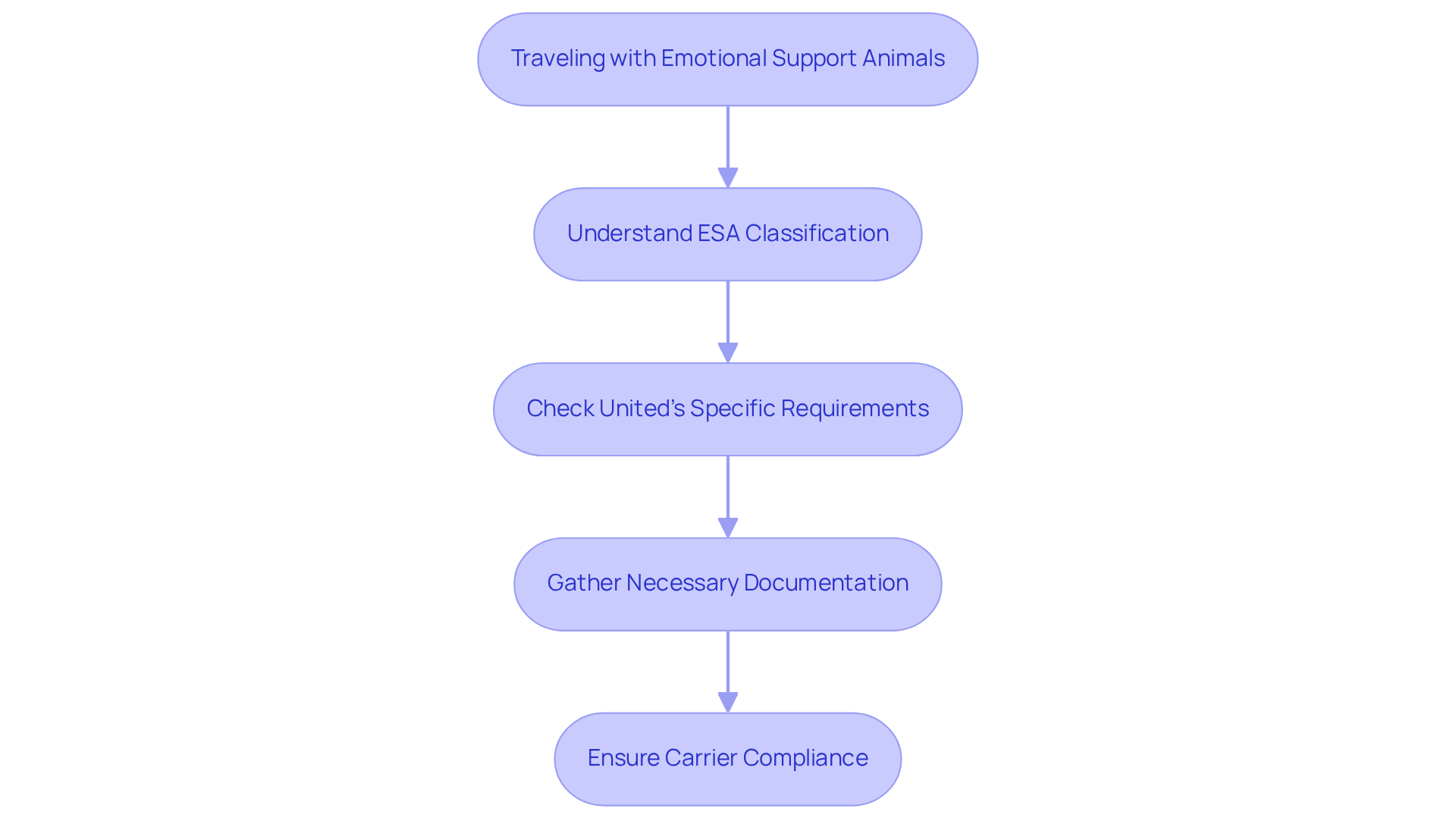
American Kennel Club: Rights and Responsibilities for ESA Owners
The American Kennel Club highlights an important distinction: while Emotional Support Animals (ESAs) offer vital companionship, they do not have the same access rights as service animals under the Americans with Disabilities Act (ADA). As guardians of ESAs, it is crucial to ensure that these animals are well-behaved and do not disrupt public spaces. This responsibility includes managing their behavior and addressing any damages caused by the animal. It’s essential for ESA guardians to recognize that their pets must be under control at all times.
Understanding these rights and responsibilities can significantly ease the journey for ESA guardians, especially when considering where can emotional support animals go in housing and travel situations. For example, landlords may ask for documentation regarding ESAs, but they cannot inquire about the specific nature of a disability, which can be a sensitive topic for many.
When it comes to travel, ESA possessors need to complete the U.S. DOT Service Companion Air Transportation Form. This form requires vaccination details and a certification that the animal is trained to perform specific assistive functions and will not relieve itself on the airplane. If a flight exceeds eight hours, the U.S. DOT’s Service Animal Relief Attestation Form must also be filled out. This form certifies that the service dog will either not urinate or defecate during the flight or can do so in a hygienic manner.
Statistics reveal that approximately 18% of pet guardians identify their pets as emotional support animals, underscoring the growing reliance on these companions for emotional assistance. As we approach 2025, it is vital for ESA custodians to stay informed about their responsibilities under the ADA and adhere to travel documentation requirements. By doing so, they can maintain access to public spaces and housing accommodations, ensuring that they know where can emotional support animals go without interruption.
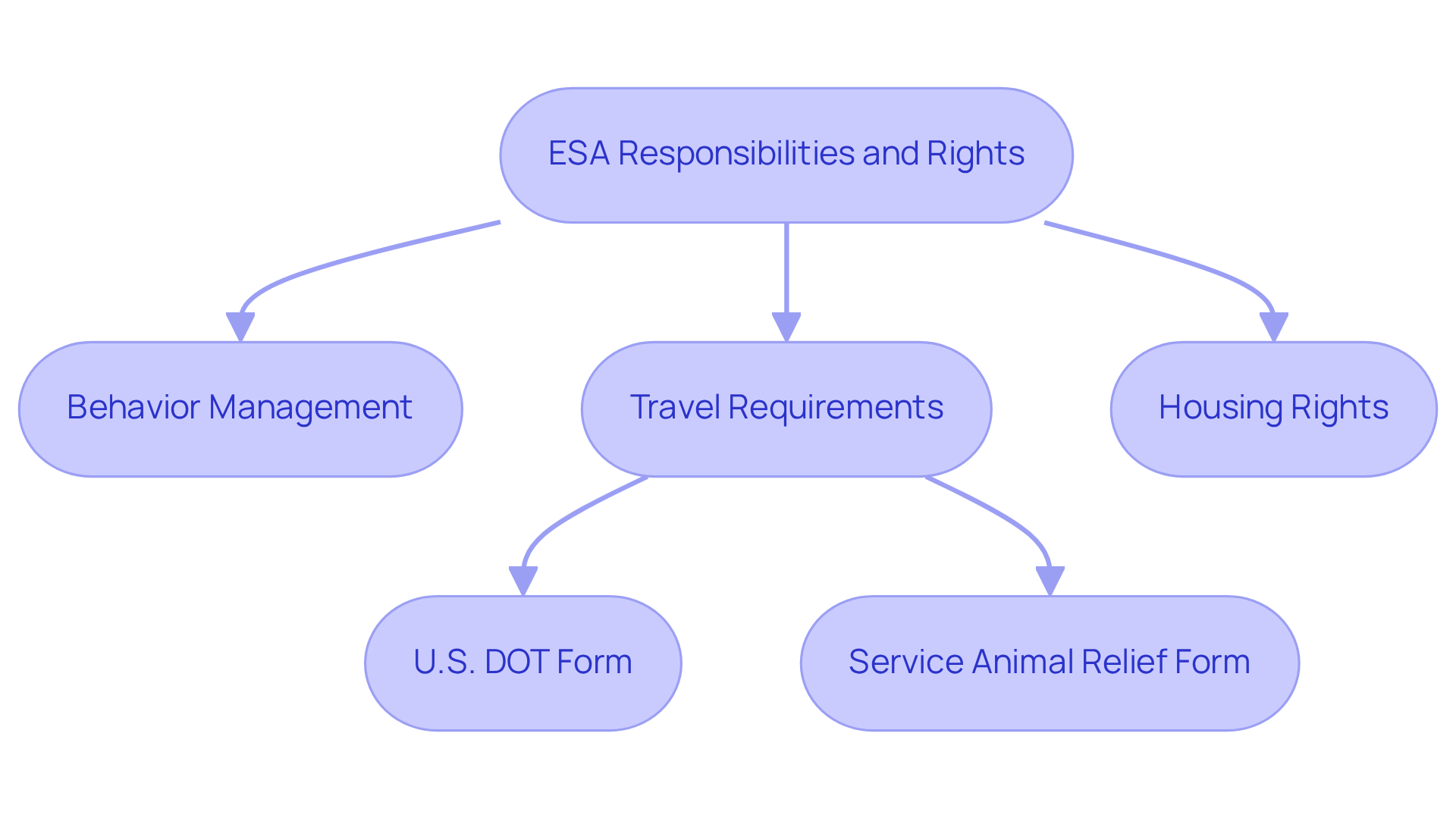
Portland Office of Equity: Local ESA Regulations and Guidelines
Navigating the emotional landscape of mental health challenges can be daunting. For many individuals, emotional support animals (ESAs) provide a source of comfort and companionship. However, it’s important to understand where can emotional support animals go, since they do not possess the same public access rights as service animals, but are nevertheless protected under housing laws. In Portland, ESA holders should familiarize themselves with local regulations to effectively advocate for their rights, particularly in rental situations where pet policies may come into play.
Wellness Wag recognizes the unique struggles faced by those seeking ESAs and offers a nurturing solution. Through our streamlined service, individuals can consult with licensed medical professionals who understand their needs. After submitting the required forms, you will be connected with a compassionate doctor for a personalized consultation to assess your eligibility for an ESA. This supportive process ensures that you have the guidance needed to navigate your journey.
Once confirmed, you’ll receive a professionally crafted ESA letter recognized by law within 24 hours. This letter serves as essential documentation, empowering you to advocate for your rights with confidence. To begin this journey toward emotional support, we invite you to visit our website, submit your forms, and schedule your consultation today. Remember, you are not alone in this process; support is available, and we are here to help you every step of the way.
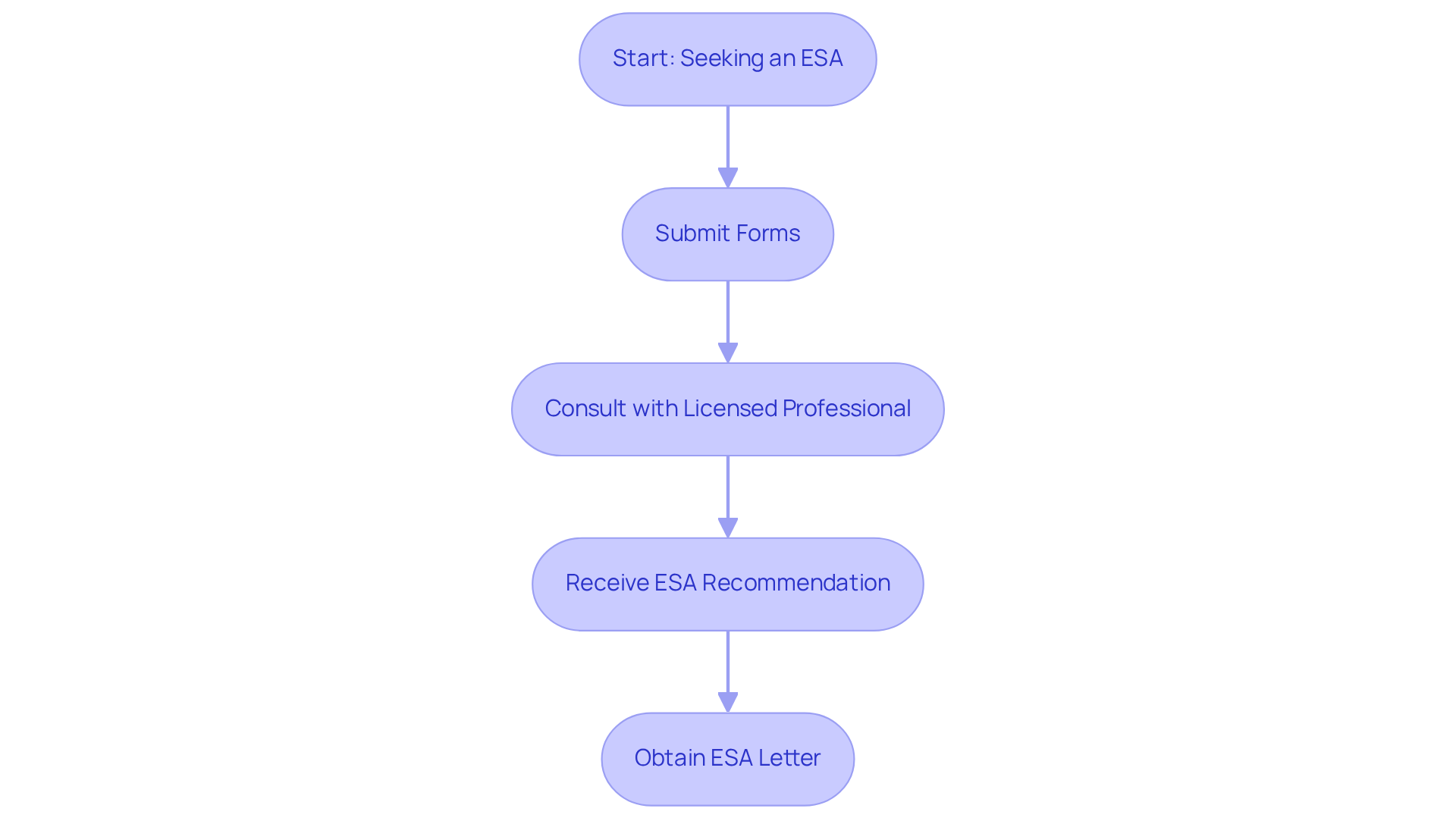
ADA National Network: Legal Insights on Emotional Support Animals
The ADA National Network clarifies that emotional support animals are not recognized as service animals under the ADA, which can limit their access to public spaces. This distinction may leave many feeling confused or unsupported, especially those who rely on the companionship of their ESAs. While there is no legal requirement for service dogs to be certified or registered, obtaining certification from recognized organizations can provide credibility and ensure that the service dog has undergone proper training. This step can help alleviate some concerns for those who may feel unsure about the legitimacy of their support animal.
Service dog handlers enjoy full public access rights under the ADA, allowing them to bring their service dogs into various public spaces, including restaurants, stores, libraries, and public transportation. This access can be crucial for individuals seeking to navigate their daily lives with the support they need. Additionally, they are entitled to housing accommodations, even in areas where pets are typically restricted. Understanding these distinctions is vital for ESA owners to know where can emotional support animals go and ensure they are aware of their rights in various settings. It’s important to recognize that while the journey can be challenging, there are supportive resources available to help guide individuals through these complexities.

Air Canada: ESA Travel Policies and Requirements
Air Canada has instituted new policies concerning emotional support animals, now classifying them as standard pets. This change means that emotional support animals must be transported in carriers and are subject to pet fees. For many individuals facing mental health challenges, figuring out where can emotional support animals go can add an extra layer of stress during travel. To avoid any complications during your journey, it’s important to ensure that you have the necessary documentation and know where can emotional support animals go according to Air Canada’s specific requirements.
Navigating these changes can feel overwhelming, but there is support available. Consider obtaining a legitimate Emotional Support Animal letter through Wellness Wag, which offers affordable and accessible services designed to ease your travel experience. This letter can serve as a reassuring solution, helping you feel more at ease while traveling with your beloved companion.
For more information on how to get started, visit Wellness Wag’s website and explore the options available to you. Remember, you’re not alone in this journey, and there are resources ready to support you on where can emotional support animals go as you travel.
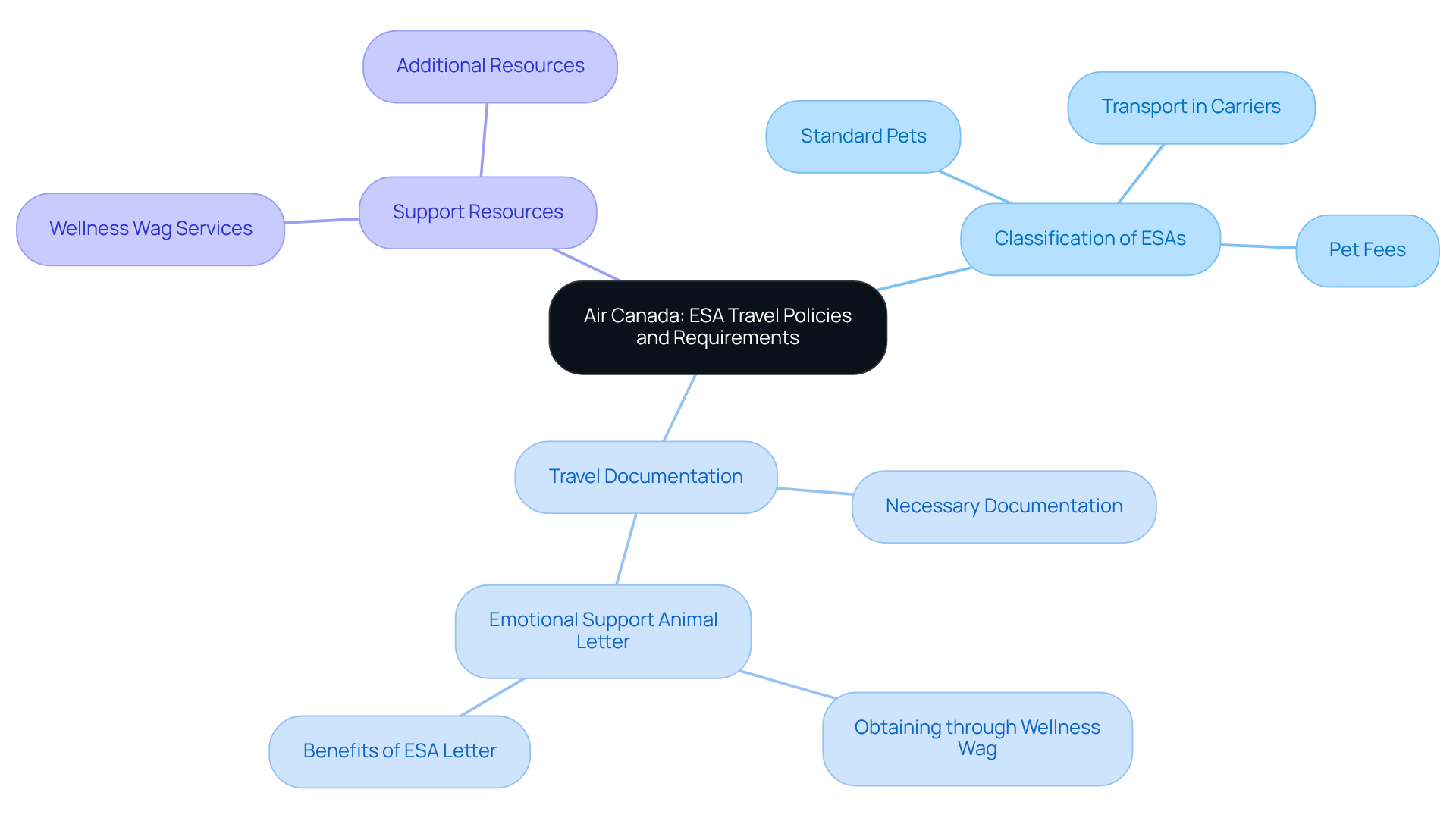
Mental Health America: Guidance on Obtaining Emotional Support Animals
Mental Health America emphasizes the vital importance of obtaining a legitimate Emotional Support Animal (ESA) letter from a licensed mental health professional. For many individuals grappling with emotional challenges, this documentation is essential to clarify where can emotional support animals go for housing and travel arrangements. As we look toward 2025, the demand for valid ESA letters continues to grow. Approximately 18% of pet owners in the U.S. now have certified emotional support animals, reflecting an increasing awareness of the mental health benefits these companions can provide.
Navigating mental health struggles can be daunting, but consulting with mental health professionals can be a pivotal step. This process not only allows individuals to articulate their needs but also ensures they receive the appropriate documentation to support their requests. Typically, this involves a brief assessment followed by a consultation, leading to the issuance of an ESA letter within 24 hours upon approval. It’s reassuring to know that as the landscape of emotional support creatures evolves, securing legitimate letters that comply with legal requirements is increasingly important. This helps facilitate rights under the Fair Housing Act and Air Carrier Access Act, offering peace of mind to those in need.
For those planning to travel with their emotional support animals, completing the U.S. DOT Service Companion Air Transportation Form is crucial. This form requires vaccination details and certification of the animal’s training, ensuring a smooth travel experience. Mental health professionals highlight that emotional support animals can significantly reduce symptoms of anxiety, depression, and loneliness. This underscores the importance of appropriate documentation, enhancing the advantages of these therapeutic companions. Remember, you are not alone in this journey; support is available to help you navigate the process and embrace the comfort that an ESA can bring.
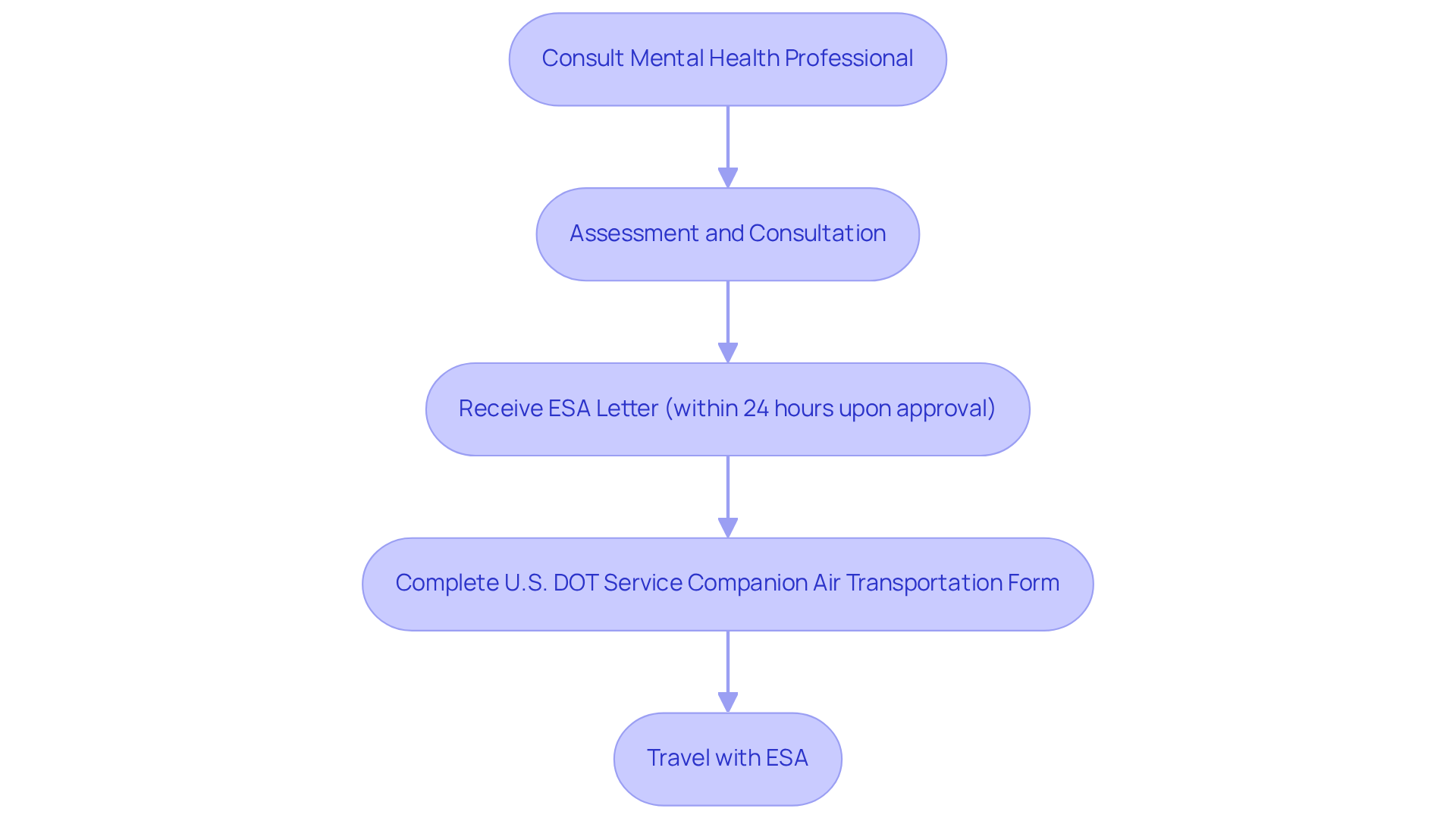
U.S. Department of Transportation: ESA Travel Regulations
The U.S. Department of Transportation has introduced new regulations that significantly impact where can emotional support animals go in terms of travel rights. Starting in 2025, it will be important to know where can emotional support animals go, as they will no longer have the same access as service animals. This change means that ESA owners must follow standard travel policies for pets, including determining where can emotional support animals go, which can involve specific carrier requirements and potential additional fees. It’s essential for ESA owners to be aware of where can emotional support animals go according to regulations to ensure compliance and avoid any complications during their travels.
Many individuals with mental health challenges rely on their emotional support animals for comfort and companionship. The thought of navigating these new travel regulations can be daunting and may evoke feelings of anxiety and uncertainty. Reports have indicated a rise in compliance issues related to where can emotional support animals go during travel, prompting the DOT to stress the importance of understanding these new guidelines.
Transportation authorities aim to clarify the distinction between service animals and emotional support animals, including where can emotional support animals go, ensuring that travel regulations are uniformly enforced. This is a crucial step in creating a supportive environment for all travelers. As you prepare for your next journey, remember that you are not alone in this process. There are resources available to help you navigate these changes and ensure a smooth travel experience with your beloved ESA.
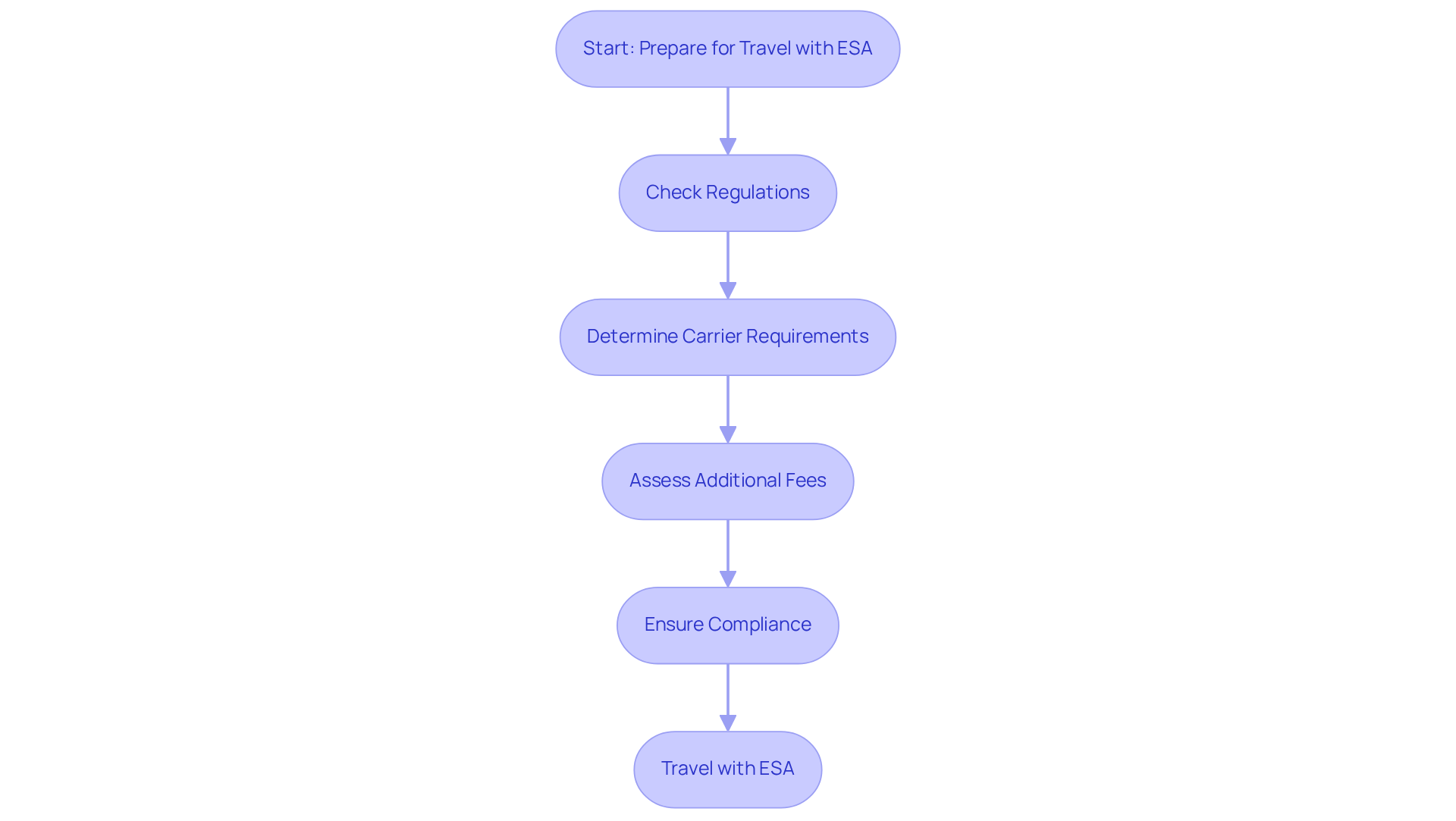
National Service Animal Registry: Understanding ESA Roles
Emotional Support Animals (ESAs) are increasingly recognized for their essential role in providing companionship and emotional support to individuals facing mental health challenges. According to the National Service Animal Registry, while ESAs significantly enhance the well-being of their handlers, they do not enjoy the same legal protections as service animals in public spaces. This distinction is vital for ESA owners to grasp, as it empowers them to navigate their rights and responsibilities with confidence.
As of 2025, the legal landscape surrounding educational savings accounts continues to develop. Under the Fair Housing Act, individuals with documented mental health disabilities can request reasonable accommodations for their emotional support animals in housing situations, even in environments that typically restrict pets. However, it is important to understand where can emotional support animals go, as they do not have the same access privileges in public areas as service animals, which are specifically trained to assist individuals with disabilities.
Experts in animal welfare underscore the importance of ESAs in therapeutic settings. Laura Curtis from the Worcester Recovery Center points out that animals can play a significant role in recovery, offering emotional support that enhances mental health outcomes. This perspective is supported by various studies indicating that the presence of animals can alleviate symptoms of anxiety and depression, fostering a sense of connection and responsibility among their owners.
Real-life examples illustrate the positive impact of ESAs in diverse settings. For instance, students have reported that their emotional support animals help them manage the stresses of college life, reducing feelings of loneliness and improving their overall emotional health. Additionally, engaging with animals in therapeutic contexts, such as Cognitive-Behavioral Therapy, has been shown to lower stress levels and enhance adherence to treatment.
In conclusion, while emotional support animals play a crucial role in promoting mental well-being, it is essential for guardians to understand their legal rights and the limitations compared to service animals. By grasping these nuances, ESA owners can advocate for their needs while cherishing the emotional benefits that their companion animals provide.
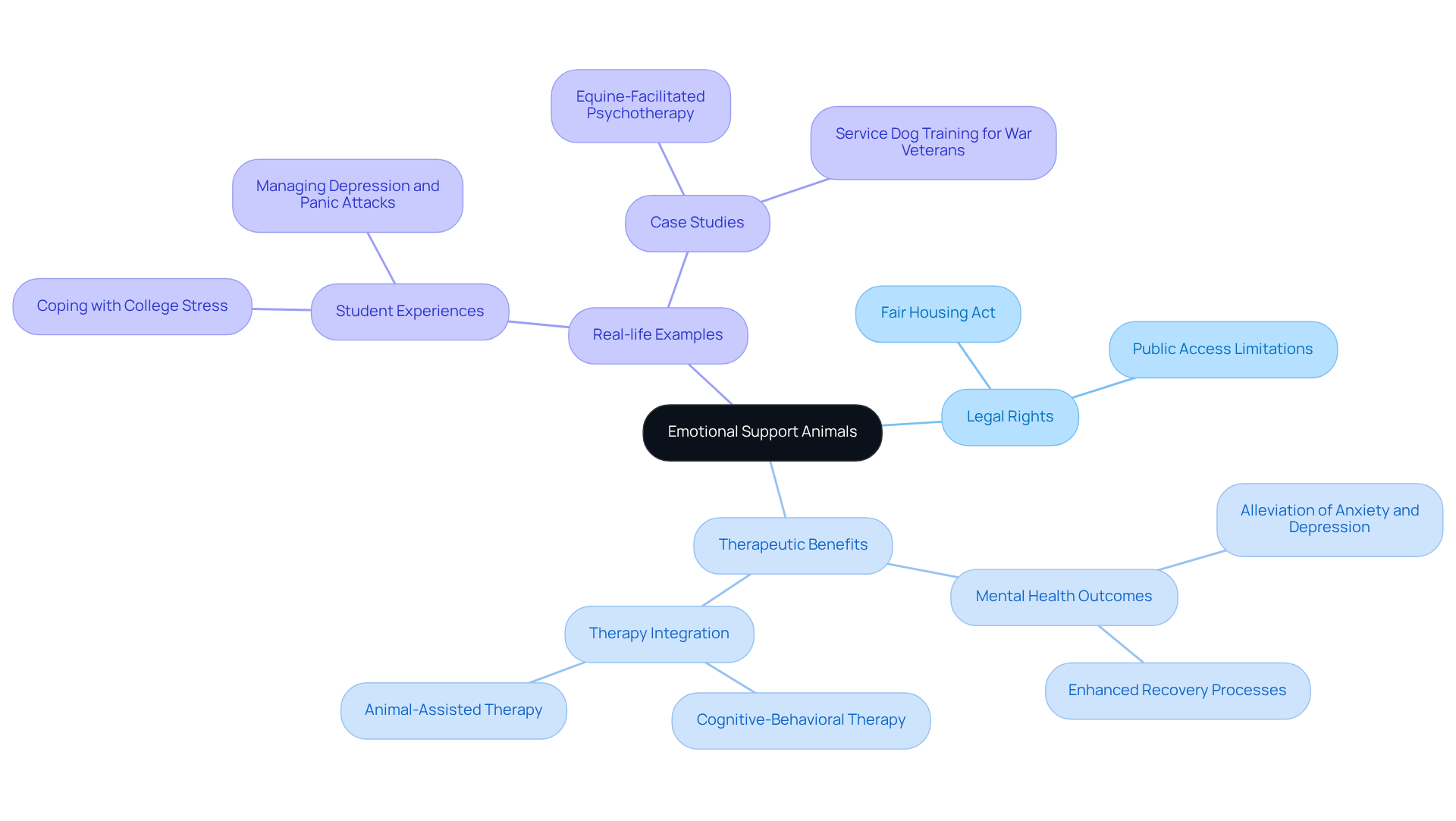
Kinship: Locations Where Emotional Support Animals Are Permitted
As the acknowledgment of emotional support animals (ESAs) continues to grow, many businesses and establishments are thoughtfully adjusting their policies to embrace these therapeutic companions. While ESAs do not have the same access rights as service animals, many establishments are becoming more welcoming, prompting questions about where can emotional support animals go. For instance, numerous hotels and rental properties now offer pet-friendly accommodations specifically for ESA holders, ensuring that individuals can travel and live comfortably alongside their beloved animals.
Examples of pet-friendly lodgings include:
- The Lakefront Anchorage, which fosters a warm atmosphere for emotional support animal caregivers
- Various public parks that invite emotional support animals to accompany their caregivers during outdoor activities
Furthermore, some retail establishments are beginning to relax their policies, allowing emotional support animals in designated areas.
Business operators recognize the benefits of accommodating ESAs, with many expressing that promoting a pet-friendly environment enhances customer satisfaction and loyalty. As Logan Miller insightfully notes, “Allowing pets in rental properties can provide numerous benefits for both property managers and tenants.”
ESA holders are encouraged to check the specific policies of each location to find out where can emotional support animals go before visiting, ensuring a smooth experience. This proactive approach not only aids in navigating potential challenges but also fosters a positive interaction between ESA owners and businesses, creating a supportive community for all.
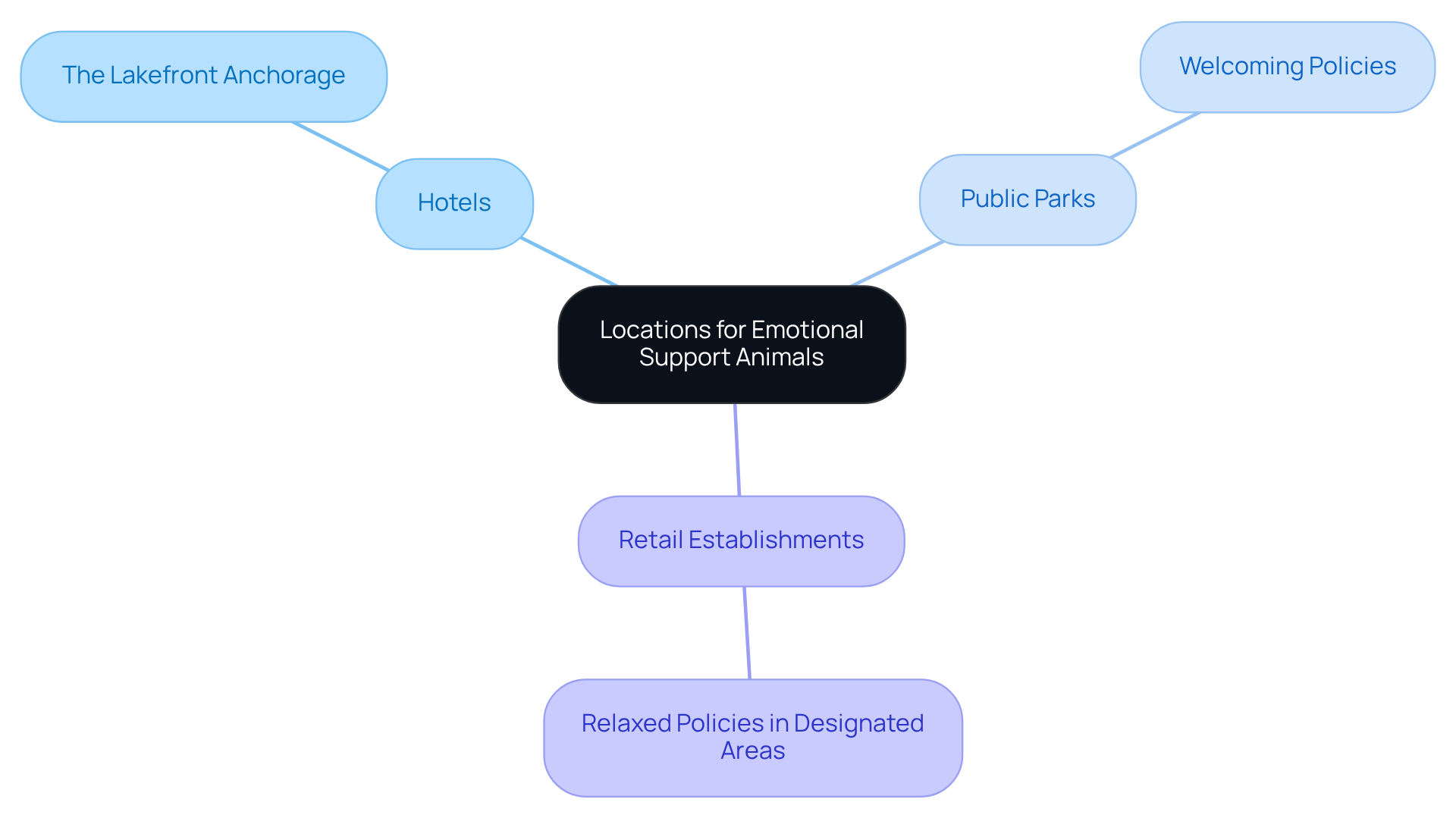
Conclusion
Emotional Support Animals (ESAs) hold a significant place in the hearts of many individuals, offering comfort and companionship during life’s most challenging moments. It is essential for their guardians to understand where these beloved animals are permitted, especially as travel regulations and access rights evolve. This article underscores the importance of obtaining legitimate ESA documentation, adhering to travel guidelines, and recognizing the distinct legal protections that set ESAs apart from service animals.
Many ESA owners face the challenge of navigating specific airline policies, local regulations, and their responsibilities as pet guardians. For instance, airlines like United and Air Canada have recently updated their policies, meaning that ESAs now travel as standard pets, which can lead to additional fees and requirements. The ADA National Network also highlights the limitations of ESAs in public spaces, contrasting them with service animals that enjoy broader access rights.
Given these complexities, it is crucial for ESA owners to actively seek resources and support to navigate their journeys. By obtaining proper documentation and familiarizing themselves with local laws, individuals can advocate for their rights, ensuring that they and their emotional support animals can travel and live comfortably together. The companionship of an ESA can profoundly enhance mental well-being, making it all the more vital to understand the evolving landscape of emotional support animal regulations and access rights. Remember, you are not alone in this journey; support is available, and your emotional well-being matters.
Frequently Asked Questions
What services does Wellness Wag offer for obtaining an ESA letter?
Wellness Wag provides quick ESA letter services, including a brief assessment to determine eligibility and a consultation with licensed medical professionals to evaluate unique needs. Clients can receive their official documentation within 24 hours of approval.
How long does it take to receive an ESA letter from Wellness Wag?
Clients typically receive their ESA letter within 24 hours of approval. However, for states with specific regulations, it may take up to 30 days for delivery as required by law.
Why is a quick turnaround for ESA letters important for travelers?
A quick turnaround is beneficial for travelers who need to secure their ESA letters before flights or accommodations, alleviating stress and ensuring compliance with legal requirements.
What changes has United Airlines made regarding emotional support animals?
United Airlines now classifies emotional support animals as standard pets rather than service animals, meaning they must travel in carriers and are subject to pet fees.
What are the main differences between emotional support animals and service animals?
Emotional support animals provide emotional comfort but do not have the same legal access rights as service animals, which are trained to perform specific tasks and have protections under the ADA.
What documentation is required for traveling with an ESA on United Airlines?
Travelers must check United’s specific requirements, which include necessary documentation and carrier specifications for their emotional support animals.
What responsibilities do ESA owners have according to the American Kennel Club?
ESA owners must ensure their animals are well-behaved, manage their behavior, and address any damages caused by the animal. They must also keep their pets under control at all times.
What forms are required for traveling with an ESA?
ESA possessors need to complete the U.S. DOT Service Companion Air Transportation Form, which requires vaccination details and certification of the animal’s behavior. If a flight exceeds eight hours, the U.S. DOT’s Service Animal Relief Attestation Form must also be filled out.
What percentage of pet guardians identify their pets as emotional support animals?
Approximately 18% of pet guardians identify their pets as emotional support animals, highlighting the growing reliance on these companions for emotional assistance.
Why is it important for ESA custodians to stay informed about their responsibilities?
Staying informed about their responsibilities under the ADA and travel documentation requirements helps ESA custodians maintain access to public spaces and housing accommodations, ensuring their animals can accompany them without interruption.
Certify Your Emotional Support Animal Today

Why You Can Rely on Us?
At Wellness Wag, we believe your pet deserves care rooted in both science and compassion. Each article is carefully researched, written in clear language for pet owners, and then reviewed by qualified professionals to ensure the information is evidence-based, current, and practical for real-life care. Our goal is to help you feel confident in making informed decisions about your pet’s health and well-being.
Reviewed by
Angela Morris, MSW, LCSW
Angela is a licensed clinical social worker with 20 years of experience in patient advocacy and community mental health. She has assisted numerous clients with ESA evaluations and brings a deep understanding of disability accommodations, ensuring that all information is accurate, supportive, and practical.

Written by :
Lena Park
Last Updated :
July 11, 2025












